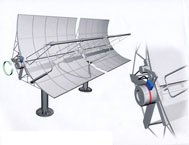Tracking the Sun: Magnetic measurement systems
 We’ve come a long way from the first solar systems, which attempted to catch whatever ray of sunlight that happened to pass them by. Now, flexible solar collectors can fully adapt to the position of the sun throughout a sunlit day. Such a capability allows them to catch each beam of sunlight during the day by means of magnetic measuring systems. This is achieved through sensors, which work according to a magnetic measuring principle, allowing them to move without any physical contact.
We’ve come a long way from the first solar systems, which attempted to catch whatever ray of sunlight that happened to pass them by. Now, flexible solar collectors can fully adapt to the position of the sun throughout a sunlit day. Such a capability allows them to catch each beam of sunlight during the day by means of magnetic measuring systems. This is achieved through sensors, which work according to a magnetic measuring principle, allowing them to move without any physical contact.
Magnetic measuring systems originated in Germany, where subsidies for photovoltaic (PV) installations on rooftops and open areas were curtailed by the German federal government, forcing solar energy systems purveyors to consider alternative methods for collecting solar energy. So far, this has not been an issue in the United States, but US solar energy providers can still welcome the savings provided by such technology.
How magnetic measuring systems work
In solar thermal power stations, sensors measure the angle of the reflectors, thereby providing a downstream control system via a position message. The required angles (i.e. set value) are stored in a controller according to the time of day (meaning: the position of the sun). As the collectors are able to assume any position, they follow the movement of the sun throughout the day.
The results of these measurements are translated into real time, which is very precise (up to 10 µm). If the sensors are reflective of high system and repeat accuracy, they can be aligned quickly with the sun to capture as much solar heat as possible. Direct radiation of the sun is then reflected by the collectors to the absorbers, where it is bundled and absorbed.
Generating power with mirrors
Two of the most advanced power stations are solar towers and parabolic trough power plants. The latter use curved through-type mirrors to “bundle” sunlight onto an absorber tube. Because of the shape of these mirrors, the sun shines 30 to 60 times stronger on the tube, allowing this concentrated energy to heat a liquid heat transfer medium, which is used to generate steam. This steam, in turn, powers a turbine and energy is generated via an electric generator.
Solar towers, by contrast, function with thousands of individual concave mirrors, each reflecting rays of the sun into a central absorber on a tall tower. In this case, the tower/absorber concentrates the solar heat onto a liquid heat transfer medium.
Installations prove the system
Though not yet in the US, applications for the parabolic trough type systems are already in use in Spain. In fact, the devices are employed in several Spanish locations, utilizing the optimal alignment of the solar collectors. A system in the Extramadura region of Spain and one in the Castile region each use approximately 2500 sensors. They employ a contactless measuring sensor with an integrated evaluation module and a digital signal output. In combination with the magnetic band MB500, these form an open measuring system with high resolution.
Magnetic sensors can also be found in power stations near Seville. Here, the sensors are equipped with an evaluation module, as well as a direct, digital signal output, and are used in combination with the MB320 magnetic band. The magnetic bands are installed quite easily by gluing, and are solidly joined with a steel carrier strip.
Applications for difficult atmospheric conditions
Because they require many sunny days, solar thermal plants are primarily located in warm regions of the world such as Spain, Australia, and the California desert. Measuring devices are equipped to perform optimally in such challenging climates. Temperatures up to 158º F are not problematic. As a result of their compact design, the measuring systems resist shocks, vibrations, as well as sand particles—which is particularly helpful in desert installations. The compact design of these applications also gives the devices a small footprint in terms of any environmental impact.
Magnetic versus mechanical systems
It seems magnetic measurement devices are replacing mechanical systems throughout the industry, especially for linear and radial measurements, angle values, and revolutions. The core element of a solar magnetic measurement is a magnetized band that is mounted to a machine. It’s equipped with a code, which is scanned by a sensor during the measurement action. This is done without any contact whatsoever. Then, integrated electronics calculate the path or angle data, making it available either as an absolute value or as incremental signals. Because of the contactless process, no wear occurs on the devices. This process saves on maintenance and replacement costs, making solar magnetic measurement systems economical to run.
Maurizio Masullo is the CEO of SIKO Products, Inc.
SIKO Products, Inc.
www.sikoproducts.com
Author: Maurizio Masullo
Volume: July/August 2011











.png?r=8255)
